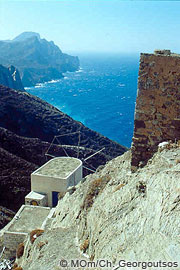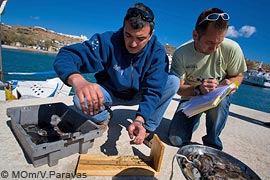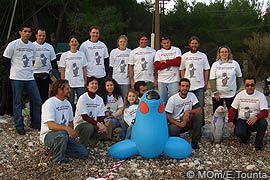

 |
||
 |
||
Vol. 10 (1): June 2007 |
||
Algeria / Greece / Italy / Madeira / Malta / Mauritania & Western Sahara / Turkey
Algeria
The article also records the first known sighting in Algeria of a hooded seal, Cystophora cristata. With a spate of strandings of hooded seals in the Mediterranean in August 2006, including at Algeciras, Malaga, Grenada, and Melilla, scientists are questioning whether erroneous species identifications might result from reported sightings. According to Manel Gazo of the Fundació CRAM in Spain: “We have now another variable to include in the equation of the presence of monk seals on Mediterranean coasts… we have to keep in mind while interviewing fishermen that they have to discern between two different species of seals!” Possibly, he adds, hooded seals in certain areas may already have been misidentified as monk seals in recent years.
|
 |
|
|
|
‘Unclear’ is the best word to describe the future of the management bodies governing protected areas in Greece.
Most Greek NGOs remain sceptical at best regarding the progress made to date by these management bodies, established almost 4 years ago by the Greek state. Lack of a legislative conservation framework (zoning and management measures) for most protected areas, delays in setting up key operational procedures, lack of personnel and an almost complete paucity of funding have left the management bodies to discuss virtual-reality conservation.
However, during the last 6 months, the newly appointed – by the Minister of Environment himself – Presidents and members of the Boards, have been activated in order to “emergency” manage the European funds allocated through the Structural Funds for nature conservation. Even though one may consider this an important positive development, the signs are at best mixed and in several cases NGOs already complain about unnecessary or even ill-conceived plans of activities within the protected areas.
Characteristic of the above situation, MOm believes, are the cases of the management bodies of 2 key protected areas for the monk seal, namely that of the National Marine Park of Alonnisos, Northern Sporades (NMPANS) and the Karpathos-Saria area in the Dodecanese.
Despite various organizational difficulties, the management body in Karpathos-Saria slowly but steadily has managed to secure funding of approximately 1 million euros, has already hired research and guarding staff and is ready to draft its management plan. In addition, it is in the last stages of initiating a series of in situ conservation activities, such as monitoring key species, a visitor awareness campaign and, most importantly, a guarding project for the area. In support of these initiatives MOm has decided to donate to the management body its vessel “Saria”, a fully equipped 9.5-meter speedboat, as well as an environmental exhibit, specially designed to present the unique natural environment of Northern Karpathos. Both were constructed as part of a previous LIFE project that MOm implemented in the area during the 2001-5 period.
In contrast, even though the NMPANS management body appears to have secured close to 3 million euros for the next 2 years, its intentions with respect to implementing key in situ conservation activities remain vague. The plan, presented by the Chairman at the latest Board meeting, is to spend close to 1.8 million euros to construct 2 vessels to be used mainly for research, purchase numerous fancy high-tech research equipment, including a submersible ROV (remotely operated vehicle), and to build a network of radars to “electronically” guard the Park. MOm’s reservations on these plans and its basic criticism that, at this stage, these should not be the management body’s priorities, are not being heard by other Board members or by Ministry of Environment officials. Unfortunately, it seems that nowadays, almost everyone’s concern, with respect to the protected areas in Greece, is only how fast the management bodies can spend the European funds allocated for nature conservation. MOm and several other Greek NGOs are not following this rationale and are planning to escalate their opposition. – Dr. Spyros Kotomatas, MOm.
 |
|
|
|
Research efforts of the MOFI project (Monk Seal & Fisheries: Mitigating the conflict in the Greek Seas, LIFENAT/GR00083), implemented in several different areas of Greece, have continued unabated, also during the current fishing season. In the National Marine Park of Alonnisos, Northern Sporades, monitoring of local fish stocks, as well as investigating monk seal – fisheries interactions, has been carried out in cooperation with local fishermen since last year. This March, similar research efforts were initiated in the area of Kimolos – Polyaigos, in the southwestern Cyclades.
In these two areas, which are of utmost importance for the monk seal population in Greece, research efforts are carried out by researchers of MOm (www.mom.gr) and WWF-Hellas (www.wwf.gr), in close cooperation with researchers from the Hellenic Fisheries Research Institute (www.fishri.gr), which is also responsible for the scientific coordination of this particular research initiative.
Furthermore, this February MOFI researchers visited the island of Kalymnos in the Eastern Aegean, where the largest coastal fishing community in Greece resides. There, in cooperation with the local fishing cooperative, surveys were conducted by extensive questionnaire. These covered a range of subjects, such as fishing effort, fish-stock conditions, interactions with marine mammals, general fishery-related problems, and potential solutions. The overall results of these research efforts will form the basis for the discussion and drafting of the Action Plan for the mitigation of monk seal and fishery interactions, which is the ultimate goal of the MOFI project. For more information, please visit: www.mofi.gr. – Panos Dendrinos and Alexandros Karamanlidis, MOm.
 |
|
|
|
It was an unusual kind of seminar for the local inhabitants of the Greek island of Alonnisos, the heart of Greece’s first National Marine Park. Still, in the freezing cold of early December, fishermen, officers of the local port authorities, fire fighters and local residents gathered at a beach to learn about and practice monk seal rescuing techniques.
Designed and delivered by MOm’s Rescue Team, the seminar gives practical and easy to learn tips on what to do when challenged with the uneasy task of helping out a Mediterranean monk seal in distress. From identifying poor health signs to how a creature weighing up to 300 kg is to be handled, were only a few of the topics covered.
Upon completion, all attendees received a certificate of participation along with a copy of the manual “Monk seal in danger. Humans to the Rescue”.
The monk seal rescue seminar is part of the MOFI project, an EU LIFE – NATURE funded project aimed at mitigating the monk seal – fisheries conflict in the Greek seas. The seminar will take place at all 7 MOFI hot-spot areas. For more information, please visit www.mofi.gr. – Calliope Lagonika, MOm.
 |
|
|
|
Blogspots have become such a common form of communication and information dissemination that Life at Faros didn’t come as a surprise. However, Dr. Giorgos Katsadorakis, MOm member and a renowned Greek ornithologist, did surprise us after all.
The adventurous ornithologist, embarked on a solitary 45-day study of the shag (Phalacrocorax aristotelis desmarestii), a protected bird sub-species, endemic of the Mediterranean that counts only 1200 pairs in Greece and about which little is known. The study took place at an uninhabited islet at the northernmost part of the National Marine Park of Alonnisos, Northern Sporades, called Psathura. There, Dr. Katsadorakis found home sweet home at a lighthouse from where he’d enjoy a magnificent view. Whenever he had time, that is, since his research also involved other bird species and the natural environment of the islet itself. On top of that he managed to maintain a very much alive and interesting blog on his everyday life.
Apparently, quite a few of us daydream about staying at a solitary islet at a protected area of remarkable beauty because the blog became a hit in no time! If it’s all Greek to you, you can still visit www.lifeatfaros.blogspot.com just for the pictures! – Calliope Lagonika, MOm.
EndQuoteVilla Monachus Villa Monachus is situated on the coast above the spectacular Blue Caves, right in the north east of the island. There is a stone pathway leading directly to the sea and the legendary Priest’s Cave which, back in olden times, was used for meditation by a monk. Source: The Zakynthos Villa Book, Luxury Villas in Greece. |
Mediterranean News continues with Italy, Madeira, Malta, Mauritania & Western Sahara and Turkey...
Copyright © 2007 The Monachus Guardian. All Rights Reserved |